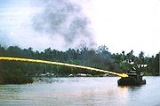
Brown-water navy
Encyclopedia
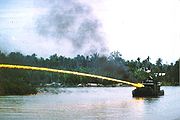
United States Navy
The United States Navy is the naval warfare service branch of the United States Armed Forces and one of the seven uniformed services of the United States. The U.S. Navy is the largest in the world; its battle fleet tonnage is greater than that of the next 13 largest navies combined. The U.S...
, referring to the small gunboat
Gunboat
A gunboat is a naval watercraft designed for the express purpose of carrying one or more guns to bombard coastal targets, as opposed to those military craft designed for naval warfare, or for ferrying troops or supplies.-History:...
s and patrol boat
Patrol boat
A patrol boat is a relatively small naval vessel generally designed for coastal defense duties.There have been many designs for patrol boats. They may be operated by a nation's navy, coast guard, or police force, and may be intended for marine and/or estuarine or river environments...
s used in rivers, along with some of the larger ships (including converted WWII LSTs) that supported them as "mother ships," from which they operated. A broader meaning is any naval force
Navy
A navy is the branch of a nation's armed forces principally designated for naval and amphibious warfare; namely, lake- or ocean-borne combat operations and related functions...
that has the capacity to carry out military operation
Military operation
Military operation is the coordinated military actions of a state in response to a developing situation. These actions are designed as a military plan to resolve the situation in the state's favor. Operations may be of combat or non-combat types, and are referred to by a code name for the purpose...
s in river
River
A river is a natural watercourse, usually freshwater, flowing towards an ocean, a lake, a sea, or another river. In a few cases, a river simply flows into the ground or dries up completely before reaching another body of water. Small rivers may also be called by several other names, including...
or littoral
Littoral
The littoral zone is that part of a sea, lake or river that is close to the shore. In coastal environments the littoral zone extends from the high water mark, which is rarely inundated, to shoreline areas that are permanently submerged. It always includes this intertidal zone and is often used to...
environments.
The term is used in contrast to the terms "green-water navy
Green-water navy
A Green-Water Navy is a naval term that refers to a naval force whose power projection capability is regional in nature. This is a relatively new terminology, as earlier non blue-water navies used to be collectively referred to as brown-water navy....
" and "blue-water navy
Blue-water navy
The term blue-water navy is a colloquialism used to describe a maritime force capable of operating across the deep waters of open oceans. While what actually constitutes such a force remains undefined, there is a requirement for the ability to exercise sea control at wide ranges...
". At one time, it was common to refer to all non blue-water navies as "brown-water navies". Today blue-water navies are generally defined as being capable of sustained oversea deployment, preferably with aircraft carriers, while green-water navies are defined as those with frigates or better, operating in coastal and regional areas.
Being a brown-water navy does not imply that it lacks offensive capability, as many small littoral-combat ships today are armed with powerful anti-ship missiles.
American Civil War
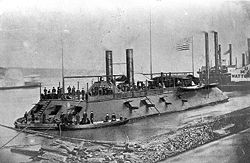
American Civil War
The American Civil War was a civil war fought in the United States of America. In response to the election of Abraham Lincoln as President of the United States, 11 southern slave states declared their secession from the United States and formed the Confederate States of America ; the other 25...
(1861–1865). As a blueprint for the "strangulation" of the Confederate States of America
Confederate States of America
The Confederate States of America was a government set up from 1861 to 1865 by 11 Southern slave states of the United States of America that had declared their secession from the U.S...
, Winfield Scott
Winfield Scott
Winfield Scott was a United States Army general, and unsuccessful presidential candidate of the Whig Party in 1852....
's Anaconda plan
Anaconda Plan
The Anaconda Plan or Scott's Great Snake is the name widely applied to an outline strategy for subduing the seceding states in the American Civil War. Proposed by General-in-Chief Winfield Scott, the plan emphasized the blockade of the Southern ports, and called for an advance down the Mississippi...
called for a two-pronged approach by first blocking the South's harbors and then pushing along the Mississippi River
Mississippi River
The Mississippi River is the largest river system in North America. Flowing entirely in the United States, this river rises in western Minnesota and meanders slowly southwards for to the Mississippi River Delta at the Gulf of Mexico. With its many tributaries, the Mississippi's watershed drains...
, effectively cutting the Confederate territory in two while also robbing the South of its main artery of transport. The U.S. Navy was assigned the blockade of the seaports, while a new force of gunboat
Gunboat
A gunboat is a naval watercraft designed for the express purpose of carrying one or more guns to bombard coastal targets, as opposed to those military craft designed for naval warfare, or for ferrying troops or supplies.-History:...
s and river ironclads, together with regular army units, would take, or at least lay siege on, the Confederate forts and cities along the Mississippi. In the early days of the war, these boats were built and crewed by the U.S. Army, with the naval officers commanding them being the only direct connection to the U.S. Navy. By the autumn of 1862, the boats and their mission were transferred to the Department of the Navy
United States Department of the Navy
The Department of the Navy of the United States of America was established by an Act of Congress on 30 April 1798, to provide a government organizational structure to the United States Navy and, from 1834 onwards, for the United States Marine Corps, and when directed by the President, of the...
. Because of the river's murky brown water, the ships that participated in these Mississippi campaigns
Mississippi River campaigns in the American Civil War
The Mississippi campaign was an economic problem created by the Union during the American Civil War in which Union Army troops, helped by gunboats and river ironclads took control over the Mississippi River, therefore virtually splitting the Confederate territory in two while also controlling the...
were quickly referred to as the brown-water navy, as opposed to the regular U.S. Navy (which was henceforth referred to as the deep-water or blue-water navy).
Gunboat Diplomacy
Save for an occasional river patrol boat, the river ironclad navy was all but abolished at the end of the Civil War. Yet the concept of a river defense force lived on in countries and regions where rivers enabled the US to project its military presence, allowing it to protect its foreign interests abroad. US river boats (gunboats) operated in portions of Chinese rivers (sometimes referred to as the "Asiatic Navy") during the 1920s, such as the gunboat , which was sunk in 1937 (by Japanese aircraft, prior to WWII), and the , which was captured by the Japanese in December 1941. The US Navy during that era was, under the terminology used then, protecting US foreign policy and her citizens abroad via "Gunboat diplomacyGunboat diplomacy
In international politics, gunboat diplomacy refers to the pursuit of foreign policy objectives with the aid of conspicuous displays of military power — implying or constituting a direct threat of warfare, should terms not be agreeable to the superior force....
". The China gunboat was lost in action March 1942.
Vietnam

American Civil War
The American Civil War was a civil war fought in the United States of America. In response to the election of Abraham Lincoln as President of the United States, 11 southern slave states declared their secession from the United States and formed the Confederate States of America ; the other 25...
, the United States Navy
United States Navy
The United States Navy is the naval warfare service branch of the United States Armed Forces and one of the seven uniformed services of the United States. The U.S. Navy is the largest in the world; its battle fleet tonnage is greater than that of the next 13 largest navies combined. The U.S...
formalized the new brown-water Navy in Vietnam
Vietnam
Vietnam – sometimes spelled Viet Nam , officially the Socialist Republic of Vietnam – is the easternmost country on the Indochina Peninsula in Southeast Asia. It is bordered by China to the north, Laos to the northwest, Cambodia to the southwest, and the South China Sea –...
. Its primary mission would be to interdict enemy re-supply, and any unauthorized contraband which might contribute to the enemy's war effort. In the beginning, the brown-water navy patrolled the inland waterways, primarily with South Vietnamese river craft (RAG—River Assault Groups) which had been mostly inherited from the French during their war; which in turn, had been received from the US, as military aid, during the French fight against the Viet Minh
Viet Minh
Việt Minh was a national independence coalition formed at Pac Bo on May 19, 1941. The Việt Minh initially formed to seek independence for Vietnam from the French Empire. When the Japanese occupation began, the Việt Minh opposed Japan with support from the United States and the Republic of China...
(Communist-led Vietnamese alliance). As the new fiberglass PBR
Patrol Boat, River
Patrol Boat, River , or PBR, is the United States Navy designation for a small rigid-hulled patrol boat used in the Vietnam War from March 1966 until the end of 1971...
(Patrol Boat, River), using water jet propulsion, became available, it became the main interdiction vessel for the inland waterways. For close coastal waters during the war, more seaworthy South Vietnamese Navy water craft were used, until replaced by newer Navy Swift Boat
Fast Patrol Craft
Patrol Craft Fast , also known as Swift Boats, were all-aluminum, long, shallow-draft vessels operated by the U.S. Navy, initially to patrol the coastal areas and later for work in the interior waterways as part of the Brown Water Navy to interdict Vietcong movement of arms and munitions,...
s (PCF—Patrol Craft Fast, aluminum 50 footers) and United States Coast Guard
United States Coast Guard
The United States Coast Guard is a branch of the United States Armed Forces and one of the seven U.S. uniformed services. The Coast Guard is a maritime, military, multi-mission service unique among the military branches for having a maritime law enforcement mission and a federal regulatory agency...
Point class cutters. By the late 1960s, the Swift Boat would commence operations alongside the PBR's in the inland waters, as well as maintaining operations along the coast line. The brown-water navy was a joint venture between the Navy and the Army
United States Army
The United States Army is the main branch of the United States Armed Forces responsible for land-based military operations. It is the largest and oldest established branch of the U.S. military, and is one of seven U.S. uniformed services...
, modeled after the earlier French Riverine and coastal patrols in the First Indochina War
First Indochina War
The First Indochina War was fought in French Indochina from December 19, 1946, until August 1, 1954, between the French Union's French Far East...
(1945–1954). In the beginning this force consisted of mostly modified surplus US WWII Landing craft (boats), such as the LCM
Landing Craft Mechanized
The Landing Craft Mechanized or Landing Craft Mechanical was a landing craft designed for carrying vehicles. They came to prominence during the Second World War when they were used to land troops or tanks during Allied amphibious assaults....
s, LCVP
LCVP
The Landing Craft, Vehicle, Personnel or Higgins boat was a landing craft used extensively in amphibious landings in World War II. The craft was designed by Andrew Higgins of Louisiana, United States, based on boats made for operating in swamps and marshes...
s, LCI
Landing Craft Infantry
The Landing craft, Infantry or LCI were several classes of sea-going amphibious assault ships of the Second World War utilized to land large numbers of infantry directly onto beaches. They were developed in response to a British request for a vessel capable of carrying and landing substantially...
s, etc. The only entirely new riverine boat from the French Indochina War had been the French designed STCN (an all-steel "V" hulled boat, approximately 40 feet in length, whose design had been influenced by the US LCVP). This particular craft influenced the design of the US Navy's only original riverine boat built for the Vietnam War; the 50-foot all-steel hull, aluminum super-structured ASPB (Assault Support Patrol Boat, better known as the "Alpha Boat"). The "Alpha" boat was built by the Gunderson Company, in Oregon, USA, and was of reinforced construction, in order to survive exploding mines. As a consequence, the ASPB earned a reputation as the "mine-sweeper" of the riverine forces. Other riverine craft included, along with the aforementioned PBRs, PCFs, and ASPBs, were the Patrol Air Cushion Vehicles (PACVs), Coast Guard Point class 82-foot patrol boats, and the Monitors (modified LCMs). Together these craft formed a Mobile Riverine Force
Mobile Riverine Force
In the Vietnam War, the Mobile Riverine Force , initially designated Mekong Delta Mobile Afloat Force, and later euphemistically the Riverines, were a joint US Army and US Navy force that comprised a substantial part of the Brown Water Navy...
, that utilized various supporting facilities, such as the Yard Repair Berthing and Messing
Yard Repair Berthing and Messing
Yard Repair Berthing and Messing were large unpropelled barges used by the "Brown Water Navy" of the US during the Vietnam War, as bases for specialized river boats. These vessels bore the hull classification symbol YRBM....
s, advance bases, LSTs
Tank landing ship
Landing Ship, Tank was the military designation for naval vessels created during World War II to support amphibious operations by carrying significant quantities of vehicles, cargo, and landing troops directly onto an unimproved shore....
, helicopter
Helicopter
A helicopter is a type of rotorcraft in which lift and thrust are supplied by one or more engine-driven rotors. This allows the helicopter to take off and land vertically, to hover, and to fly forwards, backwards, and laterally...
and seawolf units.[1]
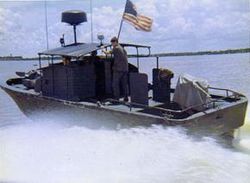
Vietnamization
Vietnamization was a policy of the Richard M. Nixon administration during the Vietnam War, as a result of the Viet Cong's Tet Offensive, to "expand, equip, and train South Vietnam's forces and assign to them an ever-increasing combat role, at the same time steadily reducing the number of U.S....
policy.
Iraq War
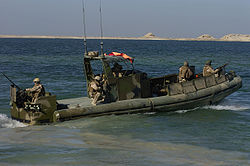
United States Marine Corps
The United States Marine Corps is a branch of the United States Armed Forces responsible for providing power projection from the sea, using the mobility of the United States Navy to deliver combined-arms task forces rapidly. It is one of seven uniformed services of the United States...
began patrolling the inland waters of Iraq
Iraq
Iraq ; officially the Republic of Iraq is a country in Western Asia spanning most of the northwestern end of the Zagros mountain range, the eastern part of the Syrian Desert and the northern part of the Arabian Desert....
soon after the beginning of the Iraq War, using a variety of patrol boats. In 2004 the Marines received a new type of fast boat, the small unit riverine craft
Small unit riverine craft
The small unit riverine craft is rigid-hull, armed and armored patrol boat used by the U.S. Marines and U.S. Navy to maintain control of rivers and inland waterways....
(SURC), to patrol the waters of the Euphrates
Euphrates
The Euphrates is the longest and one of the most historically important rivers of Western Asia. Together with the Tigris, it is one of the two defining rivers of Mesopotamia...
and deny water passage to the insurgents. Beginning in 2006, the Navy established the Riverine Squadrons
United States Navy Riverine Squadron
The Riverine Squadrons of the United States Navy are elements of the Navy Expeditionary Combat Command . According to the Navy: “The Navy’s Riverine force focuses on conducting Maritime Security Operations and Theater Security Cooperation in a riverine area of operations or other suitable area...
to assume this task from the Marines. A Riverine Squadron was deployed to Iraq in March 2007 and has been patrolling the waters of the river around the Haditha Dam
Haditha Dam
The Haditha Dam or Qadisiya Dam is an earth-fill dam on the Euphrates, north of Haditha , creating Lake Qadisiyah . The dam is just over long and high. The purpose of the dam is to generate hydroelectricity, regulate the flow of the Euphrates and provide water for irrigation...
.
See also
- Blue-water navyBlue-water navyThe term blue-water navy is a colloquialism used to describe a maritime force capable of operating across the deep waters of open oceans. While what actually constitutes such a force remains undefined, there is a requirement for the ability to exercise sea control at wide ranges...
- Mississippi Marine BrigadeMississippi Marine BrigadeThe Mississippi Marine Brigade was a Union Army unit raised during the American Civil War as part of the United States Ram Fleet. These soldiers acted as Marines aboard United States Army rams patrolling the Mississippi River...
- Maritime geographyMaritime geographyMaritime geography is often discussed in terms of four loosely-defined regions: Riverine, brown water, green water, and blue water.-Brown water:...
- Film (1966); "The Sand PebblesThe Sand Pebbles (film)The Sand Pebbles is a 1966 American period war film directed by Robert Wise. It tells the story of an independent, rebellious U.S. Navy Machinist's Mate aboard the fictional gunboat USS San Pablo in 1920s China....
." Starring actor Steve McQueenSteve McQueenTerrence Steven "Steve" McQueen was an American movie actor. He was nicknamed "The King of Cool." His "anti-hero" persona, which he developed at the height of the Vietnam counterculture, made him one of the top box-office draws of the 1960s and 1970s. McQueen received an Academy Award nomination...

